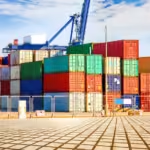In the evolving landscape of global commerce, businesses continuously seek methods to optimize their supply chains for efficiency, cost-effectiveness, and environmental sustainability. One such method gaining traction is intermodal freight transportation. This approach combines multiple modes of transport – typically truck, rail, and sea – to move goods more efficiently than relying on a single mode. Let’s delve into the benefits of intermodal freight transportation and how it can enhance your supply chain.
- Cost Savings
Economies of Scale
Intermodal transportation allows businesses to capitalize on the strengths of different transport modes. For example, rail and sea shipping are generally more cost-effective for long-distance hauls compared to trucking. By integrating these modes, companies can achieve significant cost savings.
Fuel Efficiency
Rail and sea transport are more fuel-efficient than road transport, especially for heavy and bulk goods. This efficiency translates into lower fuel costs, reducing overall shipping expenses.
- Environmental Benefits
Reduced Carbon Footprint
Intermodal transportation contributes to a reduction in greenhouse gas emissions. Rail and sea transport produce fewer emissions per ton-mile than trucks. By shifting a portion of the journey from road to rail or sea, companies can lower their carbon footprint, aligning with sustainability goals and regulations.
Lower Congestion and Pollution
Reducing the reliance on trucks for long-distance transport alleviates road congestion and reduces pollution in urban areas. This shift can lead to cleaner air and less wear and tear on infrastructure.
- Enhanced Efficiency
Optimal Route Planning
Intermodal transportation enables better route optimization by leveraging the strengths of each mode. Rail and sea transport are ideal for long hauls, while trucks provide the flexibility for last-mile delivery. This combination allows for the most efficient use of resources and time.
Reliability and Predictability
Rail and sea transport are generally less affected by traffic conditions compared to road transport. This reliability translates to more predictable delivery schedules, which is crucial for supply chain planning and inventory management.
- Increased Capacity
Handling Bulk Shipments
Rail and sea modes can handle larger volumes of goods compared to trucks. This capacity makes intermodal transport suitable for bulk shipments, reducing the number of trips required and optimizing the supply chain.
Scalability
Intermodal transportation offers scalability for businesses experiencing growth. As demand increases, companies can easily adjust their transport strategies to include more rail or sea legs, managing larger shipment volumes without compromising efficiency.
- Flexibility and Resilience
Diversified Transport Options
Relying on multiple modes of transport adds flexibility to the supply chain. If one mode faces disruptions, such as road closures or port strikes, alternative modes can be utilized to maintain the flow of goods.
Risk Mitigation
Intermodal transport reduces the risk of supply chain disruptions by spreading the dependency across different transport infrastructures. This diversification enhances the resilience of the supply chain against unforeseen events.
- Improved Inventory Management
Just-In-Time Deliveries
Intermodal transport supports just-in-time (JIT) delivery models by providing reliable and predictable shipment schedules. This precision helps in maintaining optimal inventory levels, reducing storage costs and waste.
Better Supply Chain Visibility
Advanced tracking technologies used in intermodal transport provide real-time visibility into the movement of goods across different modes. This visibility enhances decision-making and improves overall supply chain management.
Conclusion
Intermodal freight transportation offers a multitude of benefits that can significantly optimize your supply chain. From cost savings and environmental advantages to enhanced efficiency and increased capacity, this integrated approach leverages the strengths of each transport mode. By adopting intermodal transportation, businesses can achieve a more flexible, resilient, and sustainable supply chain, positioning themselves for success in the competitive global market.
Embracing intermodal freight transportation is not just a strategic move but a necessity for businesses aiming to thrive in today’s dynamic economic environment. By optimizing your supply chain with intermodal solutions, you can ensure smoother operations, greater reliability, and a stronger commitment to sustainability.



